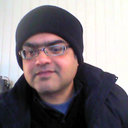Delayed gastric emptying in patients with caustic ingestion.
Atslēgvārdi
Abstrakts
BACKGROUND
Patients with caustic ingestion may develop esophageal and/or gastric cicatrization.
OBJECTIVE
Scintigraphic assessment of liquid gastric emptying time in patients with caustic ingestion.
METHODS
Consecutive patients with caustic-induced esophageal cicatrization attending the gastroenterology clinic of our institute were studied (patients with age >or=60 years, earlier gastric surgery, vagotomy, peptic ulcer disease, diabetes, systemic sclerosis, and those on gastrointestinal motility-altering drugs were excluded). Gastric emptying time was assessed by radionuclide scintigraphy (ingestion of 200 ml mango juice containing of 18.5 MBq 99mTc sulfur colloid after an overnight fast by static imaging in anterior and posterior projections in supine posture at 10 min intervals each for 1 h). A time-activity curve was generated and gastric half-emptying time (GET 1/2) was calculated. Results were compared with GET 1/2 values estimated for normal individuals in our laboratory (mean+/-2 SD). The emptying study protocol for normal individuals was the same as in patients.
RESULTS
Twenty patients (males 10) median age 32 years, 16 with acid ingestion and four with alkali ingestion, were studied. No patient had symptoms suggestive of gastric outlet obstruction or gastroparesis. Eight patients had evidence of gastric cicatrization in the form of straightening of the lesser curvature and pulling of incisura and duodenal bulb medially and loss of parallelism between the fundus and left dome of diaphragm. Gastric distensibility was however normal in them. As compared with values for normal controls (25+/-9 min), GET 1/2 was significantly prolonged in the study group as a whole (53.2+/-27.77 min, P=0.000). No significant difference was observed between different age groups, sex, or type of caustic agent consumed. GET 1/2 differed in patients (n=10) with stricture involving lower-third of esophagus (72.2+/-27.67 min) when compared with those (n=10) who had a stricture involving upper and/or middle-third of esophagus (34.3+/-8.02 min, P=0.000). In the former, GET 1/2 was maximally prolonged in patients (n=6) with involvement of the lower esophagus and reduced stomach capacity (84.6+/-27.03 min), followed by patients (n=4) with lower esophageal involvement with normal stomach capacity (53.7+/-17.41 min), but the difference did not reach statistical significance (P=0.078). Patients (n=10) without lower esophageal involvement did not have statistically significant altered GET 1/2 compared with normal controls (P>0.05).
CONCLUSIONS
Our results show that patients with caustic ingestion have prolonged liquid gastric emptying even in the absence of any gastric symptoms.



